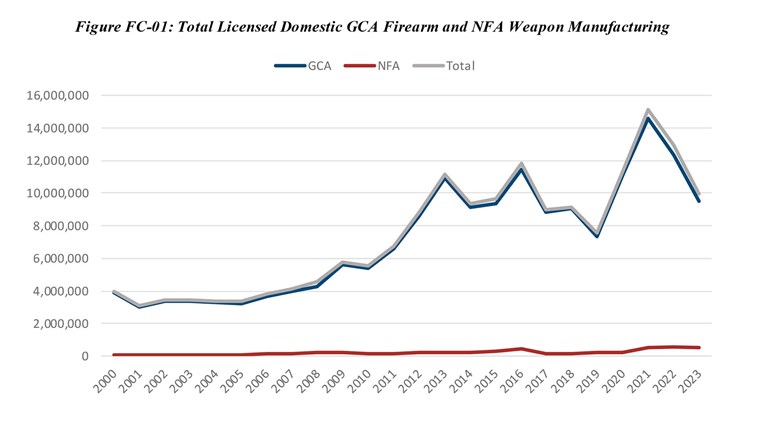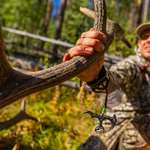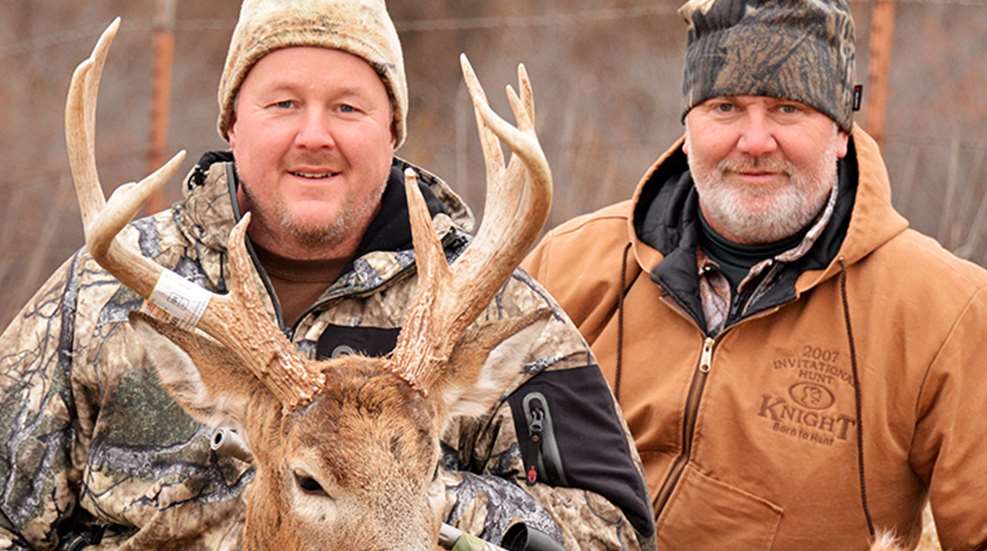
I suppose you could say the .45-70 Government is part of the family.
My grandfather Nathan Ransom Towsley was a gun guy and he, more than anybody else, is responsible for the path my life has taken. Gramp had an impressive gun collection and he loved to hunt deer. Like a lot of gun guys, he would often use several rifles over the course of a hunting season. Before his aging eyes forced him to use a scoped rifle, his absolute favorite was a Winchester Model 1886 in .45-70. He shot more than half of his whitetails and two or three of his black bears with that rifle, not to mention a lot of lesser game. (The third bear was shot with a 20-gauge shotgun and low-brass 7½ shot. That’s an adventure all by itself.) He had endless stories about the adventures he experienced hunting and shooting with that rifle, and it was one of the very few guns that stayed in the family after he passed away.
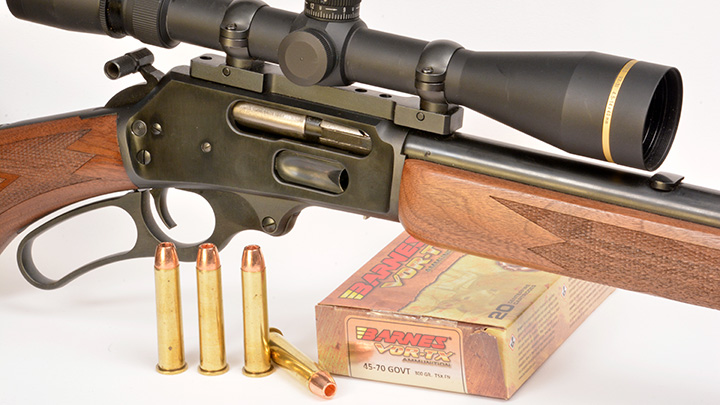
“The ol’ 45,” as he called it, was his pride and joy, and when he let me borrow it for a bear hunt it was a statement of trust. As could be predicted for a pre-adolescent kid, I soon got bored with the lack of bears and decided to bark a squirrel, Daniel Boone-style. That big 400-grain bullet hit the beech limb dead center, bending it like a bow and launching the squirrel like a catapult. He hit the ground a good distance away, rolled to a stop, stood up, shook off the dust and ran back up the tree. He stood at the junction of the limb and the trunk and scolded loud enough to alert any bears lurking about that something was up. Several times he would start out on the limb, only to lose his nerve and run back to the tree. This went on long enough that my ribs were sore the next day from laughing.
I bought a .45-70 of my own as soon as I could save up the money, and while I have never owned an 1886 Winchester, I have not been without a .45-70 since that time. I have used the cartridge in various rifles to shoot a bunch of deer, several black bears, a few hogs and two bison.
So, what does any of this have to do with hunting whitetail deer in Iowa? Quite a bit actually.
Iowa, like a lot of Midwestern states, has recently changed its regulations to allow straight-walled rifle cartridges during the shotgun deer season. I have hunted in Iowa countless times with muzzleloaders and rifle-barreled shotguns, but on this hunt I had a lever-action Marlin Model 1895. My choice of cartridge was never in doubt: it was, of course, a .45-70. My ammo was Barnes Vor-Tx with a 300-grain TSX-FN bullet. Barnes advertises the muzzle velocity at 1925 fps. After testing, I contacted Jessica Brooks at Barnes about the inaccuracy of that claim. From my rifle’s 22-inch barrel the load chronographed only an average muzzle velocity of 1924 fps.
I was getting groups averaging slightly greater than 1 MOA from the rifle. This is a good testament not only to the quality of the ammo, but also to the new Marlin rifles made with modern techniques and computer-controlled machinery.
Dope for New-Old Cartridges
This straight-wall cartridge thing is relatively new in most places and hunters are still working out the details. Southern Iowa is farm country where long shots are not uncommon. But a hunter must keep it in perspective: The straight-walled cartridges are allowed because they have a rainbow-like trajectory, not unlike the shotgun slugs they replace. The advantage for the hunter is that the rifles tend to be more consistent and are usually more accurate than slug guns. They also shoot a little bit flatter, but the key words in that sentence are “little bit.”
There are a few choices like the .444 Marlin and the .450 Bushmaster that have a slightly flatter trajectory than a factory-loaded .45-70, but the difference is not that great. None of them come close to shooting as flat as a modern, bottleneck rifle cartridge.
Some hunters I met in Iowa zero their rifles for 200 yards, but that’s not the best approach with a straight-walled cartridge. It works with a modern bottleneck rifle like my .280 Ackley Improved. With that cartridge and a 200-yard zero, the bullet will be about 1.3 inches high at 100 yards and 6 inches low at 300 yards. The .45-70 using a 200-yard zero will send the bullet 7.2 inches high at 100 yards. That’s enough to cause you to shoot over a deer in many circumstances. At 300 yards the bullet impacts 32 inches low. So where do you hold? Someplace in Minnesota, I think.
The accepted standard kill zone on a deer for figuring ballistics is 6 inches. That means the bullet must never deviate from the point of aim more than 3 inches to be certain of hitting the vitals. With a 200-yard zero and Barnes .45-70 ammo, you can hold dead on out to 40 yards and then again from 180 to 215 yards. Anyplace else in the bullet’s path is more than 3 inches above or below the line of sight. In my never humble opinion, that leaves way too much room for error to be an ethically sound approach to hunting deer.
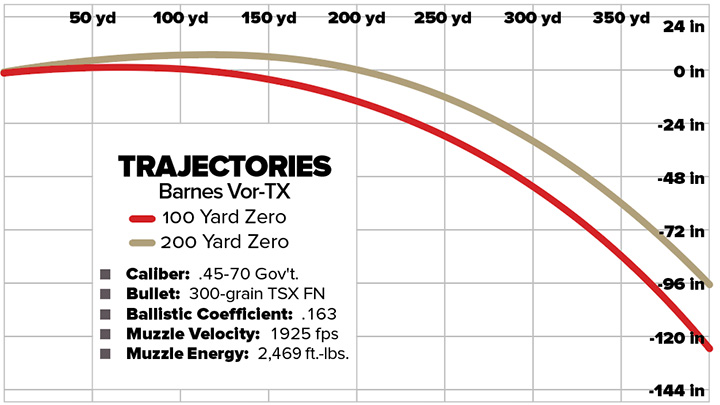
A 150-yard zero is better as it stays more or less in the 3-inch zone out to 170 yards and is an acceptable alternative. Except at 300 yards the bullet strikes 44 inches low, so now you are holding on northern Minnesota. (In retrospect, a 150-yard zero might be a better option for that open country than the 100-yard zero I used.)
When a long shot is a probability, it’s best to tear a page out of the modern long-range shooter’s handbook. At 300 yards, the .45-70 bullet is dropping at roughly the same rate as a 6.5 Creedmoor bullet is dropping at a little past 700 yards. So how do long-range shooters manage to hit the targets at up to twice that distance with the Creedmoor and other cartridges? They employ a technique called “dial up” where they turn the adjustments on the rifle’s scope to compensate for the amount of bullet drop expected at the target’s distance. Hunters can use exactly the same concept with a straight-walled cartridge, but at a much shorter shooting distance.
Another alternative is to use a scope reticle with multiple aiming points on the descending vertical leg. Given the extremely curved trajectory of straight-walled cartridges, this can work, but it is not as precise as dialing up. At hunting distances, the bullet can be dropping more than a foot every 25 yards, so you must match the exact distance to an exact aiming point. If you are off just a few yards you can miss the deer or worse. Dial up gives the option of precision where a long-range reticle does not. Often the distance falls between two aiming points on the reticle and the shooter must guess where to hold. With dial up, you can adjust for a center hold at the exact measured distance to the deer.
The .45-70 was introduced back in 1873 as a blackpowder cartridge. Originally a military cartridge, it was initially used in the “trapdoor” Springfield rifle. This rifle played a huge role in American history, but the rifle design is not strong. As a result, factory ammo must be loaded to pretty low pressure to prevent problems if it’s fired in one of these old rifles.
The upside is that the .45-70 can be handloaded for much better performance out of a modern rifle. The same 300-grain Barnes bullet can be loaded to more than 2500 fps, depending on the rifle used. That changes everything. With the 6-inch kill zone, the point-blank range (the distance where the bullet’s path is never more than 3 inches from the point of aim) is 215 yards. Just hold on the deer out to that distance.
The bullet energy is off the charts at 4,146 ft.-lbs. of muzzle energy. I recommended this handload to a friend hunting in Iowa with a strong single-shot rifle and he reported back that he has never seen anything drop deer as fast as that Barnes bullet after supersizing the ammo.
Caveats
The first consideration is the accuracy of the rifle. For example, if my Marlin is capable of 1 MOA accuracy and we use the 3-inch rule of thumb, in theory it’s accurate enough to hit a 6-inch kill zone at 300 yards as it should shoot 3-inch groups. That’s assuming there is no wind and that I break the shot perfectly. In the real world that doesn’t happen, so it’s best to leave a cushion for error.
The two other factors to consider are retained velocity and retained energy. The bullet must be traveling fast enough to expand on impact. That information is available from the bullet maker, but with these straight-walled cartridges it’s usually in the 1000 to 1200 fps minimum velocity for expansion. Of course, straight-walled cartridges use big-diameter bullets as a rule, so expansion is not as critical as it might be with a smaller caliber.
The rule of thumb on energy for deer has long been a minimum of 1,000 ft.-lbs. on impact. There are those who dispute this today, mostly to promote their pet cartridge. It’s also relative to the cartridge. A big, heavy bullet can get away with less impact energy than a small, lightweight bullet. But, it’s still a good rule to keep in mind. At 300 yards the .45-70 has dropped to 676 ft.-lbs. of energy, which is pretty marginal. With a big, heavy bullet like this you can fudge a bit and at 250 yards it is carrying 782 ft.-lbs. of energy, which I think will be enough. That also gives me a bit of wiggle room on the accuracy issue, so I picked 250 yards as my maximum ethical shooting range. I think this is a sensible maximum shooting distance for the larger straight-walled rifle cartridges like .45-70, .450 Bushmaster and .444 Marlin.
By switching to the same 100-yard zero I use with my long-range precision rifles with the .45-70, the bullet is never more than 3 inches off my point of aim out to 137 yards, so I can pretty much aim at the deer up to that distance.
Beyond that, I go to the scope and dial up. How much? There are lot of apps that will calculate that for you. I have a lot of them on my phone, but the one I use the most is called Bullet Drop. I just updated to the new version and it cost me 2 bucks.
Simply plug in the data, including the ballistic coefficient of your bullet (available at the bullet maker’s website), then enter your muzzle velocity. That, too, is available online, but advertised velocities will likely be a bit slower from your rifle. If you do not have access to a chronograph, enter the factory ammo data and you can adjust it later by actually shooting.
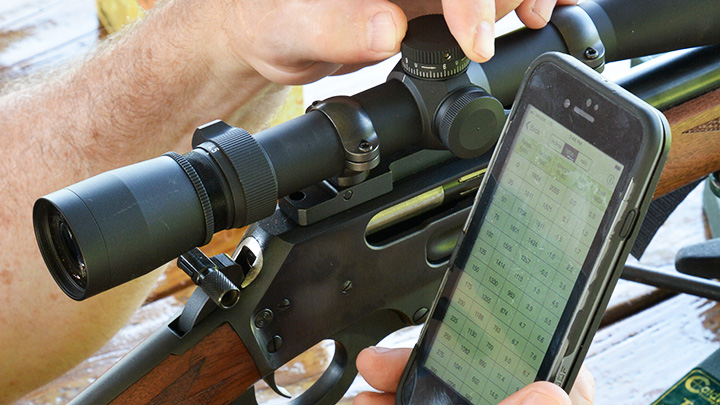
You will need a scope that is designed to be dialed up for long-range shooting. The scope adjustments will most likely be in inches, MOA or mils. Most apps will give you data for all three, so select the one you need for your scope. MOA is likely the best for this application as it has more precision than mils and keeps the math much simpler than inches.
My 4.5X-14X-40mm Leupold scope is ¼ MOA per click. So, according to my app, at 150 yards the .45-70 will impact 2.9 MOA below the line of sight. At 200 yards it’s 6.7 MOA low, and at 250 yards it’s 11.4 MOA low. At 300 yards it’s 16.8 MOA low, even though I had no plans to shoot that far. It’s best to be prepared in the event you have a wounded deer.
This is the starting point; you must prove the data on the shooting range. Use a large paper target at 200 yards to start. Never fire just one shot and call it good. Shoot a group of at least three shots from a solid rest. Five-shot groups are better. One thing to keep in mind with a lever action is that the magazine tube is attached to the barrel with a screw. This can cause a shift in the point of impact as the barrel heats up, so make sure to let the barrel cool after a few shots.
If your groups are consistently low (or high, which is unlikely) you can adjust the velocity in the app. If you are low, take 100 fps off the velocity. Then use the recalculated numbers, adjust the scope and shoot again. Once you have the groups centered on your point of aim, move to 250 yards and repeat. The groups should be on the point of aim; if not, adjust until they are. If you have the adjustments correct at those two distances, you should be on at anything closer, but shoot a target to be sure.
Once I had all my dial-up data proved on the shooting range I printed it out and taped it to the side of my rifle. Some of it I rounded up or down slightly to make it much easier to deal with.
Now, practice—a lot. Don’t just go the range one time and think you have it all nailed down. You find success in deer hunting the same way you get to Carnegie Hall: practice, practice, practice.
By the end of the summer I could consistently hit a 6-inch target out to 250 yards. I practiced at 300 as well and could hit the 6-inch target about 80 percent of the time. The next target on my range was at 400 yards, which was beyond the adjustment range of my scope, but there was a 10-inch rock at 360 yards that I could hit more often than not. That proved a couple of things to me. One, my 250-yard self-imposed limit was correct as that was the greatest distance at which I could hit 99 percent of my shots. The other thing was practicing on targets beyond that distance helped build my confidence.
The ‘Proof’ Rounds
I never pass up a chance to shoot a crop-fed Iowa doe. My chance came late one evening when a big doe stopped at almost exactly 200 yards. By the time I recovered from the recoil she was lying on her tracks. Those big bullets thump hard.
That part of Iowa had experienced a drought in 2018, which impacted antler growth. It was easy to find bucks, but much harder to find a big buck. I kept holding off, looking for Mr. Wonderful, but his invitation got lost in the mail. Late on the last afternoon of my hunt, with 20 minutes of shooting time left, a very nice buck stepped out on the edge of the field. He was by far the best I had seen and I decided to take him. As Mike Mattly called out the range I dialed up and got ready for the shot. Then we spotted another buck at the far end of the field. This one wasn’t going anywhere, so we took the time to glass the other buck. He was a bit smaller, so we turned our attention back to the first buck.
There is a huge lesson to be learned here, so focus on the next few lines. This technique is pretty reliable. Do it right and it’s all but foolproof. But, foolproof is not idiot-proof.
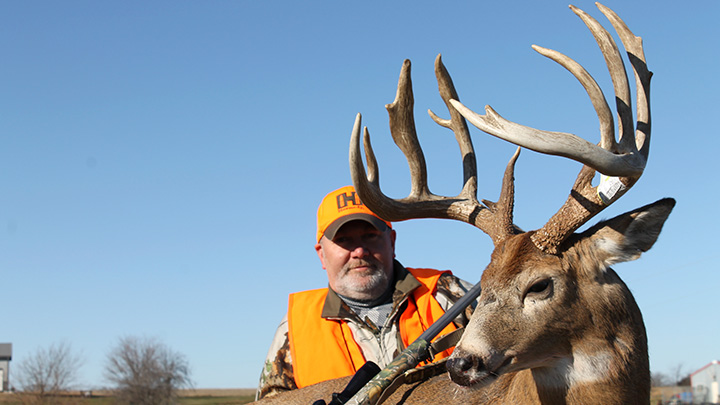
The buck had moved closer while we were glassing the second deer, and this idiot got excited and forgot to readjust the dial-up from when I was going to shoot him the first time. My shot went high, and for the first time ever I left an Iowa deer hunt without filling my buck tag.
My disappointment that night was bitter and all-consuming. Not so much that I failed to get the buck, but that the failure was mine. I can deal with the whimsy of the hunt; I do not deal well with personal failure.
I guess I can take some solace in knowing that even after more than half a century of hunting whitetails they can still induce stupidity in me. I suppose if they ever stop having that effect, it will be time to hang up my guns.














